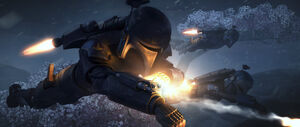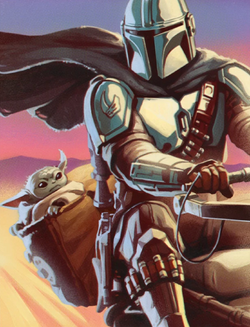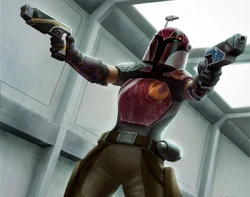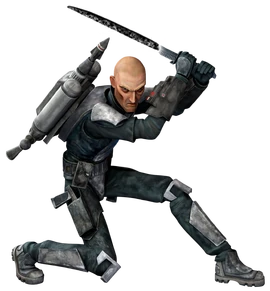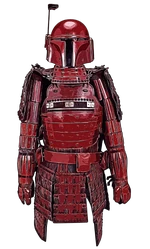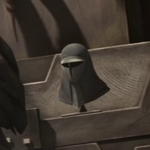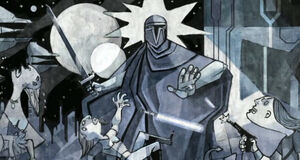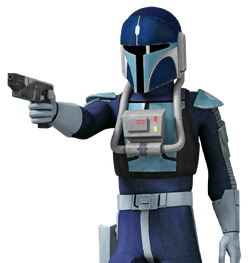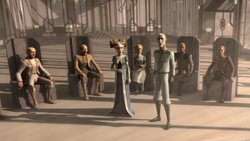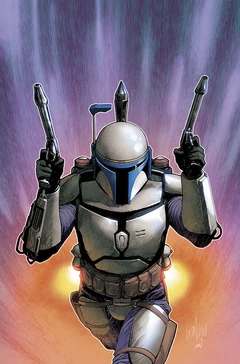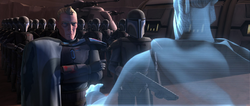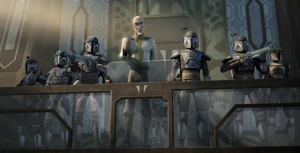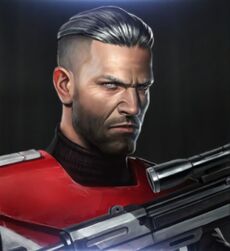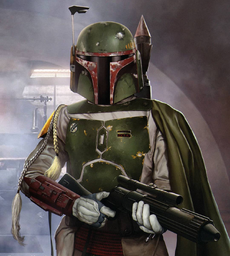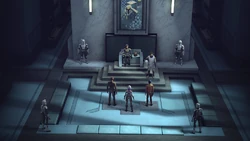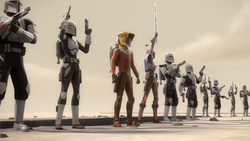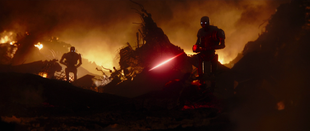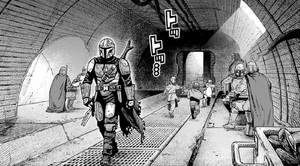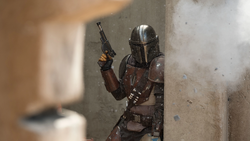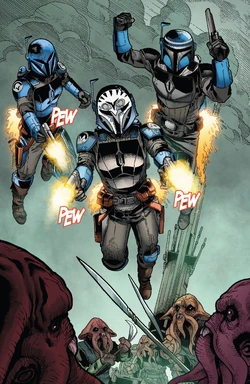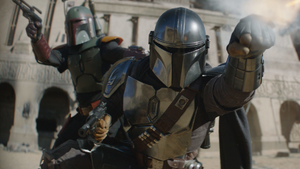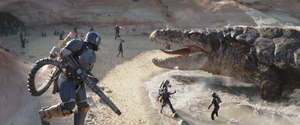Mandalorian (original) (raw)
"We'll rebuild [Mandalore]. Isn't that our history? For thousands of years, we have been on the verge of extinction, and for thousands of years we have survived."
―Din Djarin[27]
The Mandalorians—known in Mando'a as the Mando'ade ("Children of Mandalore")[28]— were a clan-based culture composed of members from multiple species and bound by a common creed, language, and code. Known primarily as highly-effective mercenaries and bounty hunters, Mandalorians as a socio-cultural group have at various points in galactic history played a major role as legendary warriors and conquerors.
Originating around the year 9991 BBY on the planet of Mandalore in the galaxy's Outer Rim Territories, the Mandalorians' way of life revolved around honor and war, being led by a sole ruler known as the Mand'alor, whose Protectors maintained a relative state of peace and unity between their people's warrior clans. As a result of their warrior culture, the Mandalorians launched several wars of expansion by the time of the Old Republic-era, colonizing nearby worlds such as Krownest, Ordo, and Concord Dawn, leading the sector surrounding their homeworld to be known as Mandalorian Space.
Throughout their history, several prominent groups of Mandalorian warriors came into existence, such as Mandalorian crusaders, rally masters, and Mandalorian Neo-Crusaders, all of whom waged war on the Galactic Republic and the Jedi Order. According to legends, many of these conflicts involved a Mand'alor who went by the name of Mandalore the Great.
In spite of this, relations between the Mandalorians and the Jedi were not always hostile, as Tarre Vizsla, a human Mandalorian, was inducted into the Jedi Order as a child, creating a lightsaber known as the Darksaber around the year 1050 BBY. Tarre eventually founded House Vizsla, claiming the position of Mand'alor, with the Darksaber becoming a symbol of leadership for both House Vizsla and the Mandalorian people as a whole.
However, after Vizsla's death, members of his house raided the Jedi Temple during the fall of the Old Republic, stealing the Darksaber and using it to reunify the Mandalorian people, waging war once more on the Jedi Order. Unfortunately, the final conflict between the Mandalorian warlords and the Jedi at the planet Mandalore led to a a cataclysm that turned much of its surface into a lifeless white desert, rendering it uninhabitable outside of hermetically sealed dome cities. After their defeat, the Mandalorians remained isolated in their sector well into the High Republic Era, not attempting to wage another war on either the Jedi nor the Republic, with which they coexisted through treaties. However, the Mandalorians' warrior ways and desire for conquest remained alive, eventually leading to infighting and civil wars.
However, although Mandalore was still under control of traditional Mandalorian warriors, much of the planet's population had become part of a pacifist movement known as the New Mandalorians, led by the young Duchess Satine Kryze of House Kryze, with the traditionalist warriors being forced to use violence to hold on to power. Eventually, around the year 42 BBY, a civil war broke out between the pacifist New Mandalorian movement and the martial traditionalists, who wished to maintain their warrior heritage. Mandalore's capital of Keldabe was destroyed during the Mandalorian Civil War, and many perished during the conflict, including Duke Adonai Kryze, Satine's father. Satine herself had to remain under protection from the Jedi Order, as the traditionalists sent bounty hunters after her. However, Mandalore's traditionalist minority was eventually defeated during the war, being exiled to Mandalore's moon of Concordia. While the Death Watch, a traditionalist group under Mand'alor Pre Vizsla, wished to retake their homeworld, the Old Mandalorians scattered across the galaxy as mercenaries.
During the Clone Wars, members of the warrior culture would align themselves with both sides of the conflict, which was secretly orchestrated by the Sith Order, who hired the Mandalorian bounty hunter Jango Fett to become the clone template for the Grand Army of the Republic, with Fett's clones being trained by the Mandalorian Protectors, while the Death Watch briefly joined the Confederacy of Independent Systems, in hopes of reclaiming Mandalore. Under the New Mandalorian government, Mandalore remained neutral and participated in the Council of Neutral Systems as a leading member. However thanks to being backed up by the criminal conglomerate known as the Shadow Collective, Death Watch was able to topple the ruling New Mandalorian regime, but the machinations of Maul, leader of the Collective, led to another civil war among the Death Watch, which split into the Collective-backed Mandalorian super commandos, and the Mandalore resistance, which was supported by the Republic. However, the conflict culminated in the occupation of Mandalore by the Galactic Republic and its subsequent government, the Galactic Empire, while Concord Dawn, the Protectors' headquarters, was transformed into a protectorate.
Following the rise of the Empire, Bo-Katan Kryze was made Regent of Mandalore, but she refused to follow Emperor Sheev Palpatine. As a result, she was replaced with Gar Saxon, a former Mandalorian super commando, who was installed as Viceroy over Mandalore, his rule enforced by the Imperial Super Commandos. As with many worlds in the galaxy, Mandalore was oppressed under Imperial rule, with weapons such as the Arc Pulse Generator being developed to pacify and rein in the war-like civilization, while the Mandalorian Protectors under Fenn Rau were forced to serve the Empire on Concord Dawn. However, during the Galactic Civil War, the Empire's rule on Mandalore was opposed by the Mandalorian resistance, which was supported by the Alliance to Restore the Republic, and was also joined by Fenn Rau after the Protectors' destruction. After the deaths of Gar Saxon and his brother and successor, Governor Tiber Saxon, Bo-Katan Kryze, after receiving the Darksaber from Sabine Wren of Clan Wren, assumed the position of Mand'alor. Kryze united the Mandalorian resistance as another civil war erupted on Mandalore, a part of the galaxy-wide struggle against Imperial rule. Kryze's reign as Mand'alor was short lived, however, and the Empire started the Great Purge of Mandalore, killing millions of Mandalorians during the Night of a Thousand Tears, while Kryze lost the Darksaber to Moff Gideon.
After the fall of the Empire and the rise of the New Republic, and following the Empire's Great Purge of Mandalore, the surviving Mandalorians went into hiding. One such group, the Tribe, hid in a covert on Nevarro. The Tribe, which was secretly part of the Children of the Watch, followed the Way of the Mandalore, an ancient religion that had fallen out of mainstream Mandalorian society. However, the Tribe was forced to relocate after its members revealed themselves to protect one of their own, the bounty hunter Din Djarin, from an Imperial remnant, which afterwards wiped out most of the Tribe's members. Djarin, who had been tasked with returning the Force-sensitive foundling Grogu to the Jedi Order, was aided in his task by several notable individuals, including Bo-Katan Kryze, Mandalore's former ruler, and Boba Fett, the son of Mandalorian bounty hunter Jango Fett.
After the hunt for Grogu was over, Djarin attempted to return to the Tribe, which had relocated to the Glavis Ringworld, only to be expelled by its members when they discovered that he had removed his helmet, which went against the Way of the Mandalore. Djarin and Fett joined forces once more, leading Fett's gotra in its war against the Pyke Syndicate, during which he was reunited with Grogu, who had decided to rejoin him. Fett and Djarin eventually defeated the Pykes, allowing Fett to establish himself as Tatooine's reigning crime lord, while Djarin and Grogu left the planet. Afterwards, Djarin was again accepted into the Tribe after traveling to Mandalore and bathing in the Living Waters to clear his transgression. In this same adventure, Bo-Katan also bathed and therefore was also unexpectedly welcomed as a member of the Tribe. However, the development allowed Kryze to walk both the path of the Way and unorthodox Mandalorian society, paving the way for her to reclaim the Darksaber and lead a united Mandalorian people in the reconquest of Mandalore.
Society and culture[]
The Mandalorian people[]
"We are a people of tradition."
―Satine Kryze[29]
Death Watch flies into battle.
Mandalorians were some of the most feared warriors in the galaxy.[30] As prideful warriors, they held combat as the cornerstone to their culture, their individual identity, and spirit.[31] Mandalorians shared a strong code[32] of honor[33] that could be invoked to settle disputes with one-on-one combat that would conclude with the death of one opponent.[10] This affinity and tradition for single combat extended beyond justice, however, as Mandalorians even sought single combat simply for the glory of fighting a great opponent, such as a Jedi Knight,[34] and even used it to settle leadership disputes. However, some in House Vizsla refused to accept non-Mandalorians like Maul from ever becoming ruler of Mandalore via such traditions. Maul himself had Prime Minister Almec lie to the Mandalorian people by claiming that Satine Kryze had killed Pre Vizsla, Maul's predecessor.[35]
The Darksaber was appropriated by House Vizsla as a symbol of authority and leadership used to unify the Mandalorians.[36] The weapon became revered and was passed down to new leaders who defeated the previous leader in combat, with claiming the weapon in any other way being considered illegitimate.[20] As well as Galactic Basic Standard, Mandalorians spoke Mando'a,[37] whose written form was also known as Mandalorian.[38]
Mandalorian clan structure was like a pyramid,[39] with the ruler, or Mand'alor,[40][1] at the top and the Mandalorian Protectors enforcing their rule. Below them were the political factions known as houses, which were made up of family clans.[39] One example was House Vizsla, which was comprised of Clan Vizsla and Clan Wren.[10] Under the rule of Duchess Satine Kryze and the New Mandalorian government during the Clone Wars, the Mandalorians had mostly rejected their martial ancestral ways but maintained a police force and secret service, who wielded electropoles and shields.[41]
Mandalorians were known to adopt lost children, referred to as foundlings.
Though Mandalorians were usually distinctly human, one did not need to be human to become one. Instead, what one needed to do was follow the Mandalorian Creed. Thus, some individuals, non-humans included, could be adopted into the Mandalorian creed as foundlings, children raised to become Mandalorian warriors.[42] Followers of the Creed viewed the foundlings as the future, and any Mandalorian with a foundling in their care was duty-bound to reunite it with their kind or to raise them, acting as the child's parent. When a foundling came of age, if he or she had not yet been reunited with its kind, they could decide to leave or join the Mandalorians,[3] and become an apprentice. According to Creed, saving a foundling was the highest honor.[43] Although Mandalorians who had been foundlings were treated no differently than any other Mandalorians, possessing the right to bear their armor[44] and even to form their own clans,[3] discrimination towards foundlings was observed to be present within Mandalorian organizations,[4][45][3] including members of the Nite Owls, who said that former foundlings did not have Mandalorian blood in their veins.[46]
Several notable foundlings included Grogu[3] and Din Djarin,[4] both of Clan Mudhorn,[3] as well as the famed Mandalorian bounty hunter[47] Jango Fett.[48] Orthodox Mandalorians,[31] such as the Children of the Watch, followed ancient religions such as the Way of the Mandalore. Mandalorians who followed the Way did not consider others as true Mandalorians, while mainstream Mandalorian regarded the Children of the Watch as religious zealots.[2] Pog soup was a traditional food of the Mandalorian people, yet Child of the Watch Din Djarin had never tasted it before meeting non-Child Bo-Katan Kryze, much to her amusement.[49]
Gear, combat, and art[]
"Ezra, the armor I wear is five hundred years old. I reforged it to my liking, but the battles, the history, the blood all lives within it. And the same goes for every Mandalorian."
"This armor is part of our identity. It makes us Mandalorians who we are."
―Sabine Wren and Alrich Wren[13]
Sabine Wren, a Mandalorian warrior and artist.
The Mandalorian Din Djarin remarked that weapons were a part of a Mandalorian's religion on more than one occasion.[18][50] The Jedi Kanan Jarrus once complained that Mandalorians only seemed to solve problems by shooting.[10] The young Mandalorian Sabine Wren, a friend of Jarrus's, once declared it was a bad idea to get between "a Mandalorian and a weapons package."[51]
Mandalorian armor developed a legendary reputation that was feared across the galaxy[52] and was visually distinctive with its honeycomb plate patterns and menacing T-shaped visors. The armor was made of beskar, a metal extremely resistant to damage and malleable enough to be forged into armor.[13] The signature innovation of the Mandalorians was the mining and tempering of beskar. The metal was found only on Mandalorian worlds.[31] An ancient tradition and vital part of Mandalorian culture was forging the beskar into armor, which was carried out by Mandalorian Armorers,[53] who could also forge beskar into other gear like whistling birds.[45] Beskar was also used to forge weapons such as crushgaunts and beskads.[54]
On top of the fabled armor, Mandalorian warriors were equipped with anti-Jedi tools such as jetpacks, magnetized boots, heads-up displays, and vambraces[55] that featured weaponry and tools designed to combat the Force abilities of the Jedi.[56] Some of this weaponry not only helped combat but outright mimicked Jedi abilities, such as their wrist-mounted sonic repulsors that knocked objects away like a Force push would.[36] One popular piece of weaponry among the Mandalorians by the time of the Imperial Era was the WESTAR-35 blaster pistols produced by Concordian Crescent Technologies.[57] Other weaponry wielded by Mandalorians included the MT-97 pistols produced by Mandalore Technologies[58] and the GALAAR-15 blaster carbine. The JT-12 jetpack[6] and Z-6 jetpack,[59] which both could launch missiles, were used by the Mandalorians.[6][59] The Rising Phoenix was the training Mandalorians undertook to enhance their jetpack skills.[3] The archetypal Mandalorian starfighter design was called the _Kom'rk_-class fighter/transport.[60]
The Mandalorians were very protective of their armor and the beskar, claiming that it belonged only to them and refusing to give it to anyone not related to the warrior culture The Mandalorian warrior Din Djarin only allowed Boba Fett to retake possession of his familial Mandalorian armor after learning that Fett was of Mandalorian heritage. However, despite the Mandalorians' claim that both their armor and beskar belonged only to them,[48] several non-Mandalorians, such as the crime lord Dryden Vos,[61] Trandoshan big game hunter Garnac,[62] and Tempest Runner Lourna Dee[63] had Mandalorian armor in their possession. Furthermore, Boba Fett's infamy led to several bounty hunters emulating the skilled mercenary by wearing knockoff Mandalorian armor, since knockoff Mandalorian gear was in no short supply in the bounty hunter profession.[21]
Additionally, some non-Mandalorian individuals also sported beskar equipment, such as Enfys Nest, who had beskar vambraces,[42] and a unidentified Arcona bounty hunter, who wore a set of beskar armor.[64] Despite not wearing a full set of Mandalorian armor, bounty hunter Carib Diss possessed a vambrace equipped with whistling birds.[65] During her alliance with Mandalorians, Ahsoka Tano was given beskar equipment.[66]
Mand'alor Pre Vizsla, leader of the Death Watch, wielding the Darksaber.
Mandalorian warriors possessed advanced combat training[55] from their many wars that were dated prior to the Republic's existence.[67] However, it was not until their conflicts with the Jedi that they developed their signature combat style.[68] This style entailed a Mandalorian utilizing a mix of melee, ranged, and hand-to-hand techniques[35] while incorporating technology into their vambraces to surprise a Jedi Knight in combat, allowing the Mandalorian to finish the Jedi off.[69] Mandalorian warriors continued to utilize this style of combat against the Jedi for some time as well as against other opponents.[70] They were also known to perform headbutts[71] known as Keldabe kisses, a term which shared its name with Mandalore's former capital of Keldabe.[72][17]
The Darksaber became a feared weapon in the days of the Old Republic as Mandalorian warriors of House Vizsla used it to slay many Jedi.[6] When the Jedi claimed the weapon and stored it in the Jedi Temple, Mandalorian warriors would raid the Temple to reclaim the weapon that had become a symbol of their warrior ways.[36] During the Clone Wars, the weapon also came to symbolize leadership of Death Watch as well as House Vizsla.[6]
Cubism was a popular Mandalorian art movement during the Clone Wars. After the war, the paintings that had depicted the awfulness of war were used to promote and glorify it instead.[37] Mandalorians typically trended towards strong angled and hexagonal lines, such as diamond and honeycomb shapes, in their architecture, vehicles, clothing, and even haircuts.[40] The Darksaber notably reflected this style, with an angular pommel, hand guard, and blade emitter.[36] Sabine Wren, a Mandalorian and a member of the Spectres, was a talented graffiti artist who personalized and painted her armor.[37] A statue of Tarre Vizsla was erected on Mandalore and became a symbol for hope and Mandalorian history. When the Empire constructed an outpost on the statue, some Mandalorians saw this as offensive, eventually destroying the outpost to restore the emblematic statue's appearance.[73] Several Mandalorians decorated their beskar armor with their clan symbols.[13] In addition, some Mandalorian armor bore the mythosaur skull emblem,[74] one of the traditional symbols in Mandalorian iconography.[37]
History[]
"Our people have suffered time and again. From division and squabbling factions. Mandalore has always been too powerful for any enemy to defeat. It is always our own division that destroys us."
―Bo-Katan Kryze[27]
The Mandalorian crusades and early expansion[]
"The Mandalorians have endured war since before the formation of the Republic."
―Fenn Rau[67]
A set of Mandalorian rally master armor.
Originating from the planet Mandalore in the Outer Rim, around the year 9991 BBY,[18] the Mandalorians' history was one of warriors who would become feared throughout the galaxy, gaining a reputation as mercenaries, bounty hunters,[55] and warriors.[75] In their past history, they were known to ride mythosaurs,[4] with the mythosaur skull emblem also becoming one of the traditional symbols of Mandalorian iconography.[37] Long before the Mandalorian cataclysm, however, the creature was thought to have gone extinct.[76] Even prior to the formation of the modern Galactic Republic, war dominated their way of life,[67] with their exploits creating the widely held belief that the Mandalorians were the greatest warriors in the galaxy.[75] In interacting with the wider galaxy, the Mandalorians became a legendary people, who would play a major role in several generations of galactic history.[77]
One group of Mandalorian warriors known as the Mandalorian crusaders[8] began waging war against other peoples to conquer their worlds.[78][28] Armor-clad and wielding swords,[28] the Mandalorians were open to laying waste to entire worlds during their crusades.[78] The crusaders conquered the planets of Krownest and Concord Dawn,[28] a planet which would see great scars that included almost a third of its planetary mass fractured and reduced to space rubble.[10] During the Old Republic-era,[79] Mandalorian rally masters, who wore distinct red armor, served as battlefield commanders during the Mandalorian wars of expansion.[80]
The ancient helmet of a Mandalorian Neo-Crusader.
Eventually, the crusaders' expansion spread to the Inner Rim, where they devastated the planet Ubduria out of contempt for the native Ubdurians, whom they viewed as dishonorable cowards.[78] In ancient times, a group of Mandalorian warriors known as the Mandalorian Neo-Crusaders existed.[9] According to the Qel-Droma Epics, at one point the Mandalorian Crusaders served under the command of the fallen Jedi Knight Ulic Qel-Droma out of the Iron Citadel on Empress Teta, and rode Basilisk war droids into combat.[8] Over the course of Mandalorian history, a united Mandalore proved to be too powerful for any outside enemy to defeat. However, it was division amongst the Mandalorian people and ensuing infighting that always brought about their downfall.[27]
War against the Jedi[]
"I know that these commandos fought in many wars, often against the Jedi."
―Obi-Wan Kenobi[6]
A Mandalorian mural depicting the crusaders battling the Jedi.
The Mandalorian crusaders' expansion eventually brought them into conflict with the Jedi Order and the Republic they protected.[81] According to ancient songs,[3] Mandalore the Great, who held the title of Mand'alor, was involved in the conflict.[3] Their first confrontations with the Jedi Knights took the Mandalorians by surprise: their use of the Force and the powers it granted them was a challenge that they had never seen before. However, the prideful nature of the Mandalorians would not allow that disadvantage to stand, and they began to devise ways to overcome the powers of the enigmatic Jedi. The result was a major advancement in the development of Mandalorian technology, specifically their arsenal and their infamous armor. They also developed a fighting style that combined their entire arsenal and skills to allow them to counteract the Jedi's supernatural abilities.[68] With these new technologies, the Mandalorians began to win their share of conflicts with the Jedi, and their warriors earned the reputation of being capable of confronting and defeating Jedi Knights.[69][55] The generations-long conflict ensured an enmity that lasted for several wars and was remembered by the wider galaxy even millennia later during the Clone Wars. These clashes between the Mandalorians and the Jedi Order became immortalized through cubist murals displayed in Mandalore's capital city of Sundari and on the moon Concordia.[6]
Tarre Vizsla, Mandalorian Jedi.
Despite their near-continuous conflicts, the Mandalorians and the Jedi were not always in conflict. The most prominent example of this was when the Mandalorian-born Tarre Vizsla, founder of the powerful House Vizsla,[18] was inducted into the Jedi Order as a child. True to his Mandalorian nature, Vizsla distinguished himself from his Jedi peers by creating a unique lightsaber: the Darksaber. At some point in his life, Tarre Vizsla became the Mand'alor, the sole ruler of Mandalore and a revered figure among his people. Following his death, the Jedi recovered the Darksaber and returned it to the Jedi Temple on Coruscant.[36] Mandalorians later honored Vizsla by building a large statue of him on Mandalore to cement his legacy.[73]
During the last centuries of the Old Republic, the Mandalorians struck at the very heart of their enemies' power: members of House Vizsla infiltrated the Jedi Temple on Coruscant and stole[6] Tarre Vizsla's Darksaber. They used the saber to conquer the entirety of Mandalore, and united the diverse houses and clans throughout their territory.[36]
Decline[]
The devastation of Mandalore[]
"Once upon a time, these plains were covered with grass. But I never saw it. This destruction happened before I was born."
―Sabine Wren[13]
A member of the Journeyman Protectors, Mandalorian lawmen who were part of the Mandalorian Protectors.
Despite the unity that House Vizsla had brought to Mandalore,[36] such was the warrior temperament of the Mandalorians that it did not last. Constant warfare and relentless campaigns of conquest ravaged Mandalore. Warlords from various clans emerged to fight the Jedi, but also to fight among themselves. The last great struggle between the Mandalorian warlords and the Jedi occurred on Mandalore itself, and caused a cataclysmic event that devastated the planet, scorching much of its surface into a lifeless, white desert.[40]
This event ended the war between the Mandalorians and the Jedi, as well as the Mandalorians' dreams of expansion. As a result of their homeworld's devastation, a major focus on reconstruction occupied the warriors for a time; the uninhabitable conditions of Mandalore's surface forced them to adapt, just as they had adapted to the Jedi's use of the Force. Instead of abandoning Mandalore, they constructed sealed dome cities, such as the capital city of Sundari.[82] Other Mandalorian clans chose to settle on worlds of the Mandalore sector, such as Clan Wren on the snow planet of Krownest,[20] while the Mandalorian Protectors established a base on the third moon of Concord Dawn.[83]
After the new Galactic Republic emerged as the dominant galactic government after the Jedi Order and Republic's final victory over the Sith in the last Jedi-Sith War,[84] the Mandalorians kept out of trouble[85] even though the Mandalorians' warrior ways and desire for conquest remained alive.[6] As the High Republic Era began to progress, the Mandalorians did not cause trouble with the Republic. During the Battle of Kur in the High Republic Era, Admiral Pevel Kronara of the Republic Defense Coalition noted that the Mandalorians had been relatively peaceful since before his birth.[85]
Pacifism[]
"Mandalore's violent past is behind us. All of our warriors were exiled to our moon, Concordia. They died out years ago."
―Prime Minister Almec[6]
The New Mandalorian Ruling Council.
In the years prior to the Invasion of Naboo, another conflict broke out between the Mandalorian people: the Great Clan Wars. The civil war was fought between competing ideals within Mandalorian society, including traditionalists who supported Mandalore's warrior past and the New Mandalorians, led by Satine Kryze. The new faction rejected the warrior past and hoped to embrace pacifism.[19] Also involved were the Mandalorian Protectors of Concord Dawn, an elite group of warriors sworn to defend the Concord Dawn system.[10] At the end of the civil war, Satine Kryze ruled as the Duchess of Mandalore, and the warrior clans were exiled to Concordia.[6] Some of these clans became the Death Watch, plotting their coup against the new regime, while others left Concordia and resettled in other parts of the galaxy, becoming the Old Mandalorians. These Old Mandalorians started working as private mercenaries, with no interest in revenge.[17]
At some point before 32 BBY,[86] a series of conflicts known as the Mandalorian Civil Wars took place,[48] in which the Mandalorian commando[87] and foundling Jango Fett participated.[48] It was during the wars that the skilled warrior obtained his distinctive Mandalorian armor.[88] While her ideals saw violent resistance from some Mandalorians, such as Death Watch,[89] Satine gradually rebuilt following the damages caused by the war. The considerable number of deaths had left Satine with a fierce hatred of violence, and she became a staunch pacifist. She reformed Mandalorian way of life. She also established a Mandalorian Government Council that had several ministers, a cabinet which was led by a Prime Minister.[29] By the time of the Clone Wars, the position was occupied by Almec. Under her rule, Mandalore prospered and turned into a modern and peaceful society.[6] This new government also eventually joined the Galactic Republic.[90]
Advent of the Clone Wars[]
The famed Mandalorian bounty hunter Jango Fett, who served as the clone template for the Grand Army of the Republic.
In the final years of the Republic, Jango Fett was considered the best bounty hunter in the galaxy.[91] The Mandalorian bounty hunter's reputation[47] attracted the attention of the Sith Order, and he was offered to become the clone template for the Grand Army of the Republic on Kamino.[92] Fett accepted the offer, and the Kaminoan cloners used his genetic material to create genetically modified clone troopers,[93] as well as two unaltered clones, Omega and Alpha,[94] the latter whom Jango would take as his son,[93] and name Boba Fett, teaching him their family's trade.[92] The Mandalorian armor Fett wore inspired that of the clone troopers. Additionally the Mandalorian Protectors also aided the Republic in training the clone troopers,[10] with at least one of Fett's clones, Bacara, being trained by an ex-Journeyman Protector.[11]
Fett's clones acted as the Republic's backbone during its war with the Confederacy of Independent Systems, a galaxy-wide conflict known as the Clone Wars.[93] When the Clone Wars erupted, Satine Kryze made sure that Mandalore and the New Mandalorians remained neutral and continued to prosper.[6] She then became leader[6] of the Council of Neutral Systems, a Galactic Senate conglomerate[95] of 1,500 star systems who wished to stay out of the conflict.[6] Nevertheless, both the Republic and CIS put heavy pressure on the Duchess to try and get her to join their respective side.[89]
Resurrection[]
"Listen, Duchess. Do you hear the people? They cry out for change. Your weak-minded rule of Mandalore is at an end. The resurrection of our warrior past is about to begin!"
―Pre Vizsla, to Satine Kryze[35]
Pre Vizsla's Death Watch allied with Count Dooku and the Separatists.
Unknown to the New Mandalorians, the Concordian governor Pre Vizsla revived the Mandalorian warrior culture as the Death Watch.[52] Among the leadership of the group was Duchess Satine's sister, Bo-Katan Kryze,[34] the leader of the Nite Owls, a group of elite female warriors.[5] Death Watch began committing terrorist acts against the pacifist regime, including attacks on Mandalore, on a Republic cruiser,[6] and on Kalevala, a planet in the Mandalore sector that had been colonized by Mandalorians. Vizsla longed to restore the warrior heritage of the Mandalorians, and conspired with Count Dooku of the Confederacy of Independent Systems, Vizsla hoped the Republic would believe an intervention was necessary, so Death Watch could fight their invasion and be hailed by the Mandalorians as heroes. However, the plot failed, and the Galactic Senate rejected the Mandalore Defense Resolution.[90]
The outcasts of Death Watch fled to become mercenaries, constructing a base on Carlac. The group began plotting for revenge, allying first with Separatist senator Lux Bonteri to plot Dooku's downfall,[34] and then with the renegade Sith Lord Maul's Shadow Collective to win back the support of Mandalore's people.[33] However, after Vizsla betrayed Maul, Maul killed him and became Death Watch's leader, prompting Bo-Katan Kryze to rebel against him, forming the Mandalore resistance.[35]
New civil war[]
Prime Minister Almec addresses the Mandalorians on Maul's behalf.
Jedi Master Obi-Wan Kenobi investigated the coup, but was captured, and Maul killed Satine to spite him. Kenobi escaped and returned to inform the Galactic Republic; in the meantime, Supreme Chancellor Sheev Palpatine, secretly the Dark Lord of the Sith Darth Sidious, captured Maul and imprisoned him in the Spire on Stygeon Prime.[5] While Maul's Mandalorian super commandos proved to be loyal and freed him,[96] his execution of Kryze was a rallying cry to many other Mandalorians, who allied together in the name of overthrowing Maul and returning Mandalore to Mandalorian control.[89]
Following the Siege of Mandalore, Bo-Katan was named Regent of Mandalore,[13] leaving Maul's hold on Mandalore to collapse.[97] Eventually, Kryze was ousted out by Clan Saxon when she refused to follow Emperor Palpatine,[13] and the planet was ultimately occupied by the Galactic Empire.[97] Meanwhile, the Protectors, who regarded Death Watch as traitors, not only assisted the Grand Army of the Republic in training clone troopers,[10] but also aided the Republic during the war. Skull Squadron, a squadron of Protectors commanded by Fenn Rau, assisted the Republic by training clone trooper pilots and fought in the Third Battle of Mygeeto.[24]
Age of the Empire[]
Under Imperial Rule[]
Gar Saxon, Viceroy of Mandalore and the Emperor's Hand.
After the Imperial occupation of Mandalore, Rau's Protectors established a base on the third moon of Concord Dawn, getting paid by the Empire to protect their system on their behalf,[83] while other Mandalorians would fall under the leadership of Gar Saxon, with some of them joining in the Imperial Military as Imperial Super Commandos.[67] Saxon, who had been appointed Viceroy of Mandalore by the Emperor, served as the latter's Hand on the Mandalorian homeworld,[20] enforcing the Empire's will alongside his fellow Imperial Super Commandos,[67] which included his brother, Tiber Saxon.[13]
Boba Fett, an infamous bounty hunter of Mandalorian heritage.
During the Imperial Era, the Quarren criminal Lallani employed a gang of Mandalorians as mercenaries and guards.[98] Meanwhile, Boba Fett, the clone son[99] of the famed Mandalorian bounty hunter Jango Fett,[47] following his father's footsteps, had become known as the best bounty hunter in the galaxy,[99] keeping the Mandalorian legacy alive by donning his father's distinctive Mandalorian armor.[99] Fett was eventually defeated by the Heroes of Yavin, and fell into the Great Pit of Carkoon,[100] though he managed to survive.[101]
Additionally, Sabine Wren, who was a member of Clan Wren, operated as a bounty hunter for a time, alongside fellow Mandalorian Ketsu Onyo.[102] However, Sabine later became a member of a small rebel cell on the Outer Rim planet Lothal,[103] known as the Spectres, who regularly raided the Imperials for supplies which they distributed to the needy,[104] and later became part of a larger rebellion, the Alliance to Restore the Republic.[105] Years later, the Alliance would ally itself with several Mandalorian clans during its war with the Empire.[13][106][17] Meanwhile, Ketsu continued with her bounty hunter career, joining the Black Sun crime syndicate.[102]
Galactic Civil War[]
"If we had shown half that spine to the Empire we would've never lost our planet."
―Bo-Katan Kryze, to Koska Reeves and Boba Fett[107]
In 2 BBY, Gar Saxon and his Imperial Super Commandos wiped out the Mandalorian Protectors; as a result, Rau decided to join the rebellion.[67] Later that year, Sabine Wren found the Darksaber on Dathomir after she, Kanan Jarrus, and Ezra Bridger fought a battle there against Maul.[108] At the urging of Fenn and the rebel leaders Hera Syndulla and Jarrus, Sabine agreed to begin training with the Darksaber so that she could reunify her people and rally them to help the rebellion.[36]
Countess Ursa Wren meeting her daughter Sabine.
Following Sabine's training, she, Rau, Jarrus, and Bridger returned to Krownest to Clan Wren's Stronghold. There, Sabine attempted to convince the clan's leader and her mother, Countess Ursa Wren, to join the rebellion. At first, Ursa decided to surrender the Jedi to Viceroy Saxon and his Imperial Super Commandos in exchange for the Darksaber and sparing her daughter. When Saxon branded her and Clan Wren enemies of the Empire, Ursa and her son Tristan fought Saxon and commandos alongside Rau and the Jedi. When Saxon tried to kill Ursa with the Darksaber, Sabine took Bridger's lightsaber and fought Saxon. Sabine was then able to reclaim the Darksaber and subdue Saxon. When Saxon tried to shoot Sabine, he was killed by Ursa. His death created a power vacuum among the Mandalorians. Sabine then decided to stay behind and help her mother, clan, and Rau find Mandalore's true leader, to whom she would give the Darksaber.[20]
Soon afterward, Bridger returned to Krownest, having escaped from the Battle of Atollon, to request help from Clan Wren for the rebels against Grand Admiral Thrawn, who was attacking the rebel base on Atollon. Although unable to send a full force, due to their current struggles against Clan Saxon, Ursa agreed to allow Sabine, Tristan, and Rau to lead several Mandalorian volunteers and ships to accompany Ezra and Chopper back to Atollon. The Gauntlet and several Fang fighters traveled back to Atollon, where they destroyed the Interdictor vessel that was preventing the rebels from escaping. Able to escape, the remaining rebels fled the system, while the Mandalorians returned to Krownest.[106]
Two warring groups of Mandalorians aligned on opposite sides of the Galactic Civil War fought for control of Mandalore.
In 1 BBY,[109] Clan Wren under the leadership of Ursa and Sabine fought on Mandalore against Clan Saxon and the Empire. At some point during the Mandalorian civil war, Sabine and her younger brother, Tristan, arrived at the statue of Tarre Vizsla and discovered that the Empire had built an outpost situated on it. Sabine and Tristan destroyed the outpost and restored the statue to its original state.[73] Clan Wren was joined by several other factions and clans including the sole Journeyman Protector Rau, Lady Bo-Katan's Clan Kryze, Clan Vizsla, Clan Rook, and Clan Eldar. Sabine and the Rebel Alliance's Spectres Jarrus and Bridger also attacked an Imperial prison hoping to find Alrich Wren, although Alrich had been moved.[13]
Sabine then offered Kryze the Darksaber, but she refused knowing she was not the leader her sister, Satine, had been. Together they attacked a convoy guarded by the super commandos. They were then able to rescue Alrich. However, the commandos and the Empire then deployed an AT-DP armed with the "the Duchess" weapon prototype that disintegrated numerous warriors of Clans Wren and Kryze. Only Tristan and Ursa survived the onslaught. The survivors then regrouped. Sabine and Bo-Katan then planned to destroy it by sneaking aboard Governor Tiber Saxon's Star Destroyer near Sundari to atone for her role in creating the weapon.[13]
The combined Mandalorian and rebel forces managed to infiltrate Saxon's Star Destroyer. Following a skirmish, they destroyed the Duchess and Saxon's vessel. After the battle, Lady Bo-Katan assumed the Darksaber and the mantle of leadership over the Mandalorian clans. The Vizslas, Wrens, Kryzes, Rooks, Eldars, and the sole remaining Protector, Fenn Rau, pledged allegiance to the new Mand'alor.[13] The rogue Children of the Watch were appalled that Kryze had taken the Darksaber as a gift instead of winning it in combat, believing it cursed their world to fall.[18]
At some point, the Rebel Alliance received help from the Old Mandalorian faction; a battalion of Mandalorians from Vlemoth Port aided Rebel forces against an Imperial task force led by Ralchio Nervi during the Battle of Xorrn.[17] Much like Fenn Rau, Mandalorians Bodica Venj and Dirk Ullodin fought for the rebels. Venj was a wrathful Mandalorian warrior who once flew a Fang fighter on approach to the Wren Stronghold on Krownest during their service to the rebels, while Ullodin wanted to become a commando and, at some point during their rebel service, took part in a space battle, where they flew a Fang fighter and shot down a TIE fighter.[110]
Great Purge of Mandalore[]
"I did surrender. After our forces were annihilated in the Night of a Thousand Tears and defeat was imminent, I met with Moff Gideon. The ISB had reached out to me to negotiate a cease-fire. In exchange for submitting to the Empire and disarming, all remaining cities and Mandalorian lives were to be spared. That is how Moff Gideon came to possess the Darksaber. I didn't trust him, but it was the only chance I had to save our people. And then he betrayed me and we were helpless to resist the Purge of Mandalore."
―Bo-Katan Kryze[27]
KX-series security droids massacre Mandalorian survivors during the "Night of a Thousand Tears."
Kryze's reign as Mand'alor was short lived. Realizing they would never be able to control Mandalore and wanting to make sure no other faction could, the Empire instead launched Great Purge of Mandalore,[2] killing millions of Mandalorians. During the purge, Mandalore was heavily bombed in the Night of a Thousand Tears.[18] The Children of the Watch[2] avoided the Purge, as they were cloistered on Concordia.[18]
With the destruction of most of her forces in the Night, Kryze was forced to agree to a ceasefire talk proposed by the Imperial Security Bureau on the belief that surrender was the only way her people could survive. While she did not trust him, Kryze met with[27] an ISB officer named Gideon[2] and surrendered the Darksaber, further agreeing to disarm her people and submit to the Empire in return for an end to the fighting. However, Gideon betrayed her. The Emprie continued the Purge against the defenseless-Mandalore[27] and almost totally destroy the Mandalorian people.[18]
New Republic Era[]
Hunt for Grogu[]
"When one chooses to walk the Way of the Mandalore, you are both hunter and prey. How can one be a coward if one chooses this way of life?"
―A Mandalorian armorer[45]
A tribe, known simply as "the Tribe," went into hiding after the Great Purge.
Following the Great Purge, surviving Mandalorians went into hiding,[45] and the Mandalorian people were believed to have perished completely.[75] In the years following the fall of the Empire, the once-great warriors became fewer and fewer, and beskar also became rarer and rarer.[111]
By circa 9 ABY,[112] a Mandalorian tribe affiliated with the Children of the Watch[2] was hiding in a covert on Nevarro, a world in the outer reaches of the galaxy. One of its members was the bounty hunter Din Djarin, known as "the Mandalorian." After Djarin did business with an Imperial remnant, it caused a disturbance within the covert, with one member, Paz Vizsla of Clan Vizsla,[18] calling Djarin a coward for dealing with the Imperials.[45]
Soon after the confrontation as well as a conversation with a Mandalorian known as "the Armorer," Djarin decided to go against the remnant and rescue Grogu, an infantile member of Yoda's species whom he had captured and turned over to the Imperial remnant. However, after he performed a rescue, he was stopped by the Bounty Hunters' Guild, who sought good relations with the local Imperials. Then, Mandalorians from the covert emerged from hiding and fought against the Bounty Hunters' Guild, protecting one of their own. Djarin escaped, but, as a result of openly fighting, the Tribe was forced to relocate the covert.[45]
Din Djarin, a renowned Mandalorian bounty hunter.
Despite the attempts of the Tribe to relocate the covert, a large majority of them had been killed by Moff Gideon's Imperial remnant. The Armorer was among those who survived, and it was speculated that others escaped Nevarro. When Djarin returned to Nevarro, the Armorer established "Clan Mudhorn" as Din Djarin's clan, consisting of Djarin and Grogu. Djarin was then tasked to reunite Grogu with the Jedi Order.[3] Vizsla survived the attack as well.[18]
During this time, Lady Kryze and two of her followers, Koska Reeves and Axe Woves, were highjacking Imperial shipments on Trask. Their goal was to use the shipments to reclaim Mandalore and have Kryze reinstated as the Mand'alor. Kryze also enlisted the aid of Djarin in exchange for locating a surviving Jedi—Ahsoka Tano. With Djarin's help, Kryze and her followers were able to take the cruiser and its cargo. Unfortunately, the cruiser's captain refused to reveal the location of the Darksaber and took his own life.[2]
Bo-Katan Kryze and her followers attack Quarren fishermen to save Din Djarin.
After helping Kryze, Djarin continued with his quest to return Grogu with the Jedi Order,[2] protecting his foundling from several bounty hunters that were hunting the youngling,[45] as well as from Gideon's Imperial remnant. Despite Djarin's efforts, Gideon eventually succeeded in capturing Grogu, forcing Djarin to ask out his allies to help him rescue Grogu.[48] Djarin assembled a team consisting of New Republic Marshal Cara Dune, Master Assassin Fennec Shand, and Boba Fett.[113] Djarin and Fett also met with Kryze and Reeves on the desert planet of Lafete, asking the Nite Owls for help in boarding Gideon's light cruiser. After a brief fight between Reeves and Fett, the latter who had felt insulted by the Nite Owls' comments on his clone origin, Kryze agreed to help Djarin, since she wished to retrieve the Darksaber from Gideon.[107]
With the Nite Owls' help, Djarin's team was able take control of the cruiser. However, Djarin had taken the Darksaber from Gideon, but could not to give it to Kryze freely.[107] The forces Kryze had gathered, including Reeves, rejected her once she returned without the Darksaber[114] and struck out under Woves as mercenaries for hire.[46]
War for Tatooine[]
"The way I see it, we have two choices. We wait until they get into position and launch a siege on their terms."
"Or?"
"We rush out there, catch them unaware. Then we can escape to your ship at the palace."
"I can't abandon Mos Espa. These people are counting on me."
"Okay, then. We'll both die in the name of honor."
―Din Djarin and Boba Fett[115]
After rescuing Grogu and reuniting him with the Jedi Order, Djarin continued his career as a bounty hunter, while Boba Fett went to Tatooine to establish his own gotra, coming into conflict with the Pyke Syndicate, a powerful faction of the Spice Cartel.[116]
Boba Fett and Din Djarin during the Battle for Mos Espa.
After completing a mission on Glavis Ringworld, Djarin rejoined the survivors of his tribe at a new covert, where the Armorer recounted the Purge and reforged his beskar spear into an armor for Grogu. Djarin was challenged and dueled Paz Vizsla, a descendant of Tarre Vizsla, for ownership of the Darksaber, and managed to defeat his rival. However, he was expelled from the Tribe for removing his helmet, which was against the Way of the Mandalore, the tribe's way of life. According to Creed, the only way for him to be redeemed was in the Living Waters beneath the Mines of Mandalore, which he thought to be destroyed. After this, Djarin also made his way to Tatooine, where he was hired by Boba Fett to aid him in his war against the Pykes.[18]
Fett and Djarin fought together against the Pyke forces during the Battle of Mos Espa, and it was during the battle that Djarin was reunited with his foundling Grogu, who had decided to return to Djarin, instead of continuing his Jedi training. Eventually, the Pykes were defeated by the Fett gotra, securing the Fett gotra's position as the leading criminal organization of Tatooine, while Djarin and Grogu left the planet.[115]
All roads lead to Mandalore[]
New covert[]
The Mandalorian Tribe defends itself against an attacking beast during Ragnar's initiation.
Despite Vizsla's fear that he, Djarin, and the Armorer were the only survivors of their clan,[18] other survivors of the Tribe would re-surface. The Armorer's tribe was able to re-establish itself[117] as a covert at a new location on a planet, where they were led by the Armorer once more.[114] Vizsla and his foundling son Ragnar were amongst the group.[43] During Ragnar's initiation ritual, the covert came under attack by a dinosaur turtle. Several Mandalorians were eaten by the turtle until Djarin killed it with his N-1 starfighter. Djarin, despite being an apostate, spoke with the Armorer about traveling to Mandalore to find the mines and redeem himself. The Armorer agreed to allow him to go on his quest. Following a run-in with several pirates belonging to Pirate King Gorian Shard's gang of the Pirate Nation, Djarin traveled to Kalevala. There, he spoke with Kryze about returning to Mandalore. However, she declined since she refused to take the Darksaber from Djarin and was abandoned by her forces to become mercenaries for hire. She chose to stay in exile at Kryze Castle.[114]
Djarin, Grogu, and R5-D4 traveled to Mandalore. Once there, they ventured into the ruins of Sundari where the three of them ran into trouble from Alamites. Djarin was captured by a cyborg scavenger and its Spider Tank. Grogu was able to escape it and the alamites back to the Djarin's starfighter which was piloted by R5. Grogu was able to convince Kryze to help him rescue Djarin. Together, they were able to get past the alamites and was able to use the Darksaber to kill the cyborg and its tank.[49]
Kryze then took Djarin to the Mines and the Living Waters. There, Djarin was able to redeem himself. However he tripped and fell deep into the water. Kryze jumped in after. In the waters, Kryze discovered a mythosaur.[49] After filling a flask with some of the Living Waters, Djarin, Kryze and Grogu left. Kryze and Djarin went to Kalevala to retrieve his fighter. However, Kryze came under attack by several TIE/IN interceptors. Djarin and Kryze were able to destroy several interceptors. However, another group of TIE/sa bombers destroyed Kryze Castle. Kryze, distraught, went after the bombers. However, a dozen more interceptors came. Djarin was able to convince her to retreat and follow her to his covert's planet.[118]
Upon their arrival at the covert, Djarin and Kryze were looked on as apostates until the Armorer confirmed that they truly been to Living Waters of Mandalore. Djarin was accepted and Kryze, despite not believing in the Children of the Watch's beliefs, was accepted into their covert.[118] During the covert's training of its children, Ragnar was taken by a shriek-hawk. Kryze led Djarin, Vizsla, and several others to rescue Ragnar. They were successful and captured the shriek-hawk's children. During this time, the Armorer forge new armor for Grogu and a new pauldron for Kryze to signify her discovery of a mythosaur.[43]
Fighting the Pirate Nation at Nevarro[]
The covert was then approached by Adelphi Rangers' Captain Carson Teva of the New Republic. Their location was revealed by Djarin's astromech, R5. At first, Djarin and his covert were hesitant to hear the captain until he told them of High Magistrate Karga's and Nevarro's attack by Pirate King Shard's gang. Following Captain Teva's departure, Djarin and Kryze spoke with the covert's members about helping Nevarro.[117] Despite fighting several of Karga's guild hunters that forced them to relocate the covert[45], Vizsla and the others agreed to help Djarin in fighting Shard's pirates.[117]
With Kryze's Gauntlet starfighter and Djarin's starfighter, the Mandalorians were able to fight the pirates and drive them from both the city and Nevarro. In gratitude for their actions, High Magistrate Karga gave the Tribe lands they could call their own for the first time in years. Shortly after, Kryze was summoned by the Armorer at the covert's former workshop. The Armorer allowed Kryze to take off her helmet,[117] saying that due to her seeing a mythosaur,[49] the time had come for all Mandalorians to reunite and reclaim Mandalore. Thus, Kryze, Djarin, Grogu, and R5 set off to find Kryze's fleet and reunite both Mandalorian tribes.[117]
Privateers on Plazir-15[]
During this time, Woves and other Mandalorians were using Gideon's light cruiser to carry out mercenary work in the Mid Rim territories. One mission involving Woves' Mandalorians capturing Captain Shuggoth's lover in order to return him to his parent, a Mon Calamari Viceroy.[46]
Woves and his fellow privateers also accepted a job to protect the pacifist planet of Plazir-15 led by the the Duchess and her husband, Captain Bombardier. Kryz and Djarin arrived and helped the Duchess and Captain in stopping a former Separatist, Commissioner Helgait, from turning Plazir's droid workforce back into battle droids. Djarin and Kryze met up with Woves and his Mandalorians in an attempt to reclaim her leadership position. After a brief fight between Kryze and Woves, Djarin gave the Darksaber back to Kryze, due to her rescuing him from a cyborg on Mandalore, thus making him unworthy to hold the saber according to the Mandalorian code, with Woves and his fellow Mandalorians accepting Kryze as their leader once more.[46]
Reconquest of Mandalore[]
After uniting Kryze's unit and Djarin's tribe, the Mandalorian fleet traveled to Mandalore. A small scouting team led by Kryze and Djarin was sent to surveil the ground. On the planet's surface, they met with Mandalorians who had survived on their own since the Great Purge of Mandalore. This group of survivors led the scouting team to the Great Forge. Upon arriving to the forge, they were ambushed by Gideon's armored commandos and led into a trap inside a hidden Imperial base where Gideon, clad in Mandalorian-style beskar armor, attempted to force the surrender of the Mandalorians. However, they managed to escape with Vizla staying behind to allow the rest to escape, with him being killed by three Imperial Praetorian Guards shortly after.[27]
Woves went into orbit and alerted the fleet about the incoming TIE interceptors and bombers. He ordered all the Mandalorians on board their Imperial light cruiser to evacuate. Woves then piloted the light cruiser as bait for the Imperials while the rest went on to reinforce their brethren on the ground. While the Mandalorians and the Imperial commandos engaged in aerial combat, Djarin, Kryze, and Grogu dueled Gideon. In the middle of the battle, Gideon managed to destroy the Darksaber using his armor's mechanized strength. However, with their united efforts, Gideon and his forces were defeated just before their former light cruiser crashed into the base, killing Gideon and whatever remained of his forces, with Grogu using the Force to protect Djarin and Kryze from the blast. Shortly after the battle, Mandalorians gathered at the Living Waters to witness Ragnar Vizla and Grogu becoming Mandalorian apprentices. A ceremony was later held to reignite the Great Forge, signifying the reclamation of their homeworld as a united people.[119]
Mandalorians in the galaxy[]
Galactic influence[]
"Never get between a Mandalorian and a weapons package."
―Sabine Wren[51]
Mandalorian armor struck fear in the hearts of many across the galaxy.[52] During the Clone Wars, the Trandoshan big game hunter Garnac kept a Mandalorian Neo-Crusader helmet as a trophy.[9] Boba Fett, a human male bounty hunter of Mandalorian heritage, wore armor inherited from his father Jango Fett, a famed Mandalorian bounty hunter[47] raised as a foundling,[48] keeping the memory of the Mandalorians alive well into the Galactic Civil War.[120] Jango's armor inspired those of the soldiers cloned from him, starting a design lineage that continued down to the stormtroopers of the First Order.[1]
After the Great Purge[]
"Our people are scattered like stars in the galaxy. What are we? What do we stand for?"
―Din Djarin, after the Great Purge[49]
Following the Great Purge, the majority of the Mandalorians had been killed,[75] making them a rare sight in the galaxy. One group known as "the Tribe" survived and hid on Nevarro,[45] but many were exterminated by an Imperial remnant. Afterward, Din Djarin was tasked with searching the galaxy for Grogu's species as their own clan.[3] The Armorer and Paz Vizsla were able to regroup on Glavis Ringworld[18] and eventually rejoin other survivors of the Tribe on a planet.[117] The last of Clan Tal after his fellow Mandalorians were wiped out in the Great Purge, the Mandalorian Aran Tal fought in the Hunters of the Outer Rim competition. He once declared that, with the loss of Mandalore and his clan, it was his responsibility to maintain the traditions of all his fellow Mandalorians.[58] Several Mandalorian war banners decorated the entrance of Maz Kanata's castle on the planet Takodana.[121]
Behind the scenes[]
Joe Johnston's concept art exploring the "supercommandos"
When The Empire Strikes Back was in pre-production, there was an idea for a squad of "supercommandos" from the Mandalore system armed with weapons built into their white suits.[122] The costume prototype was repainted for Boba Fett, and the idea of the Mandalorians was paid lip service to in The Empire Strikes Back novelization by Donald F. Glut. As mentioned in the novelization, the Mandalorians were now imagined as "a group of evil warriors defeated by the Jedi Knights during the Clone Wars."[123]
When it came time to introduce the Mandalorians in season two of The Clone Wars, George Lucas and Dave Filoni looked at Mandalore in the Expanded Universe and decided to keep the broad strokes of their history.[40]
Filoni wanted to give the Mandalorian people's appearance a "Nordic flavor." The Clone Wars art department looked at Fett's armor and translated its angles, particularly the diamond shape on the breastplate, into every aspect of the Mandalorian aesthetic. Filoni and Lucas felt it should be made clear that the ancient Mandalorians were an army, not a ragtag band of warriors wearing customized armor, so Death Watch would look uniform. (The decision also kept Boba Fett's armor unique.) Filoni hoped to eventually show how the Mandalorians became mercenaries who supplied Fett with his unusual armor.[40] When Death Watch reappeared in season four's "A Friend in Need," the characters were given a greater variety of gear, lending them what Lucas described as a "biker gang feel."[124]
Before its cancellation, The Clone Wars was to depict the Siege of Mandalore. Writer Henry Gilroy said Mandalore was likely occupied by the Republic before it turned into the Empire. He speculated due to Mandalore's importance, it was likely a "soft occupation," with a new Mandalorian puppet leader ruling the planet.[39] Star Wars Rebels has since confirmed that the Mandalorian named Bo-Katan Kryze became Regent of Mandalore following the Siege, and was deposed by Emperor Palpatine following the end of the Republic.[13] The Siege was later depicted in The Clone Wars revival on Disney+.[125]

